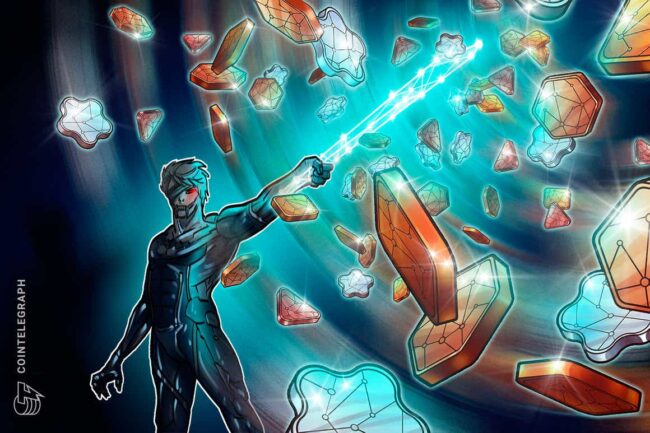While Bitcoin remains in a cool-off period after thrusting to its all-time high in early November and the decentralized finance (DeFi) sector in an apparent dry spell, gaming tokens seem to have taken the spotlight as massive gains are seen across the industry.
The Sandbox’ SAND captured headlines as it spearheaded the enthusiasm for gaming tokens, with over 340% gains in the past month. Another one is GALA, with a similar 300% rally in November. Such coins, including those under the metaverse sphere like Decentraland’s MANA and Illuvium’s ILV, gained momentum after Facebook’s rebranding to Meta, suggesting that gaming tokens could be preceding a new altcoin season.
An altcoin season is defined as when a majority of the top altcoins outperform Bitcoin (BTC) over a set period. For example, Cointelegraph Markets Pro uses two weeks in its algorithm, and it currently broadcasts a 40% reading in favor of altcoins. This means altcoins have fared better than BTC over the two-week time period.
However, the top 10 cryptocurrencies by market capitalization had mixed results against BTC over the past month, and it is the leading tokens in the gaming sector that outclassed Bitcoin. SAND, of course, has been the frontrunner since October, but Axie Infinity Shards (AXS), Enjin Coin (ENJ), ILV and Ultra’s UOS had better gains compared with Bitcoin throughout November.
An investment in ILV back in September would be up by more than threefold and one in SAND by at least sevenfold. Overall, most of the tokens in the gaming sectors have appreciated by more than 100% against Bitcoin in the last month.
Why did gaming tokens take off?
The apparent popularity of gaming tokens stems from the marriage of cryptocurrencies and gaming. The two are forging a new ecosystem where crypto enthusiasts and gamers intertwine. Most are aware of Axie Infinity by now, as the Pokemon-like game exploded in popularity due to its play-to-earn (P2E) model. Initially, players breed monsters called “Axies” using experience points rather than a “currency” within the game. The Smooth Love Potion (SLP) token was not introduced until the release of the Community Alpha on Dec. 19, 2019. From there, the game picked up steam, particularly among developing countries like the Philippines since it provided a way to earn income amid the pandemic last year.
Moreover, nonfungible tokens also play a part in the success of the sector. The NFT hype was hot on the heels of 2020’s DeFi summer, and 2021 has been its breakout year. While artworks and collectible items gained the most publicity early on, games like Axie Infinity and Dark Country buffered the industry in May’s market downturn.
NFTs introduced the element of ownership within games. For Axie Infinity, this could be the Axies, which are valued by their rarity and aesthetic elements or its game’s in-game assets. Battle of the Guardians has quite the same concept, while for something like Splinterlands, these are the trading cards. Ostensibly, the capability to uniquely verify the attributes and uniqueness of digital assets is what breathed a new dynamic for gaming.
Attracting investments
As the popularity of gaming tokens continues to rise, more investments get funneled into the space. In 2021, about $3.7 billion has been raised by blockchain companies involved in gaming, a 414% increase from 2020, per BlockchainGamerBiz.
Forte, the most notable among these, secured $725 million in a Series B funding round led by Sea Capital and Kora Management. Forte plans to expand its product offerings and services and attract more game publishers onto its blockchain gaming platform. Fantasy soccer game Sorare also bagged a whopping $680 million back in September, which boosted its valuation to $1.2 billion.
OpenSea, an NFT marketplace that deals with game assets and other digital assets, is also among the unicorns in the space. Such deals signify the burgeoning growth of this class of tokens.
Future of blockchain gaming
The gaming sector of the broader cryptocurrency market is still relatively small. The top gaming tokens only boast about a $21 billion market cap — which is inconsequential compared with Bitcoin. This means that sector dominance is still there for the taking, as the market can change rapidly, especially since games, by design, may come and go. The argument, however, is whether the play-to-earn model can keep everyone interested.
Download the 36th issue of Cointelegraph Consulting’s bi-weekly newsletter in full, complete with charts and market signals, as well as news and overviews of fundraising events.
For instance, Axie Infinity’s scholarship program lets users with more capital bear the initial costs of playing the game for players (called “scholars”) who can’t afford them, and the two parties share the SLP generated.
Axie Infinity has created a new digital ecosystem, and it continues to rake in more users. However, if players are more interested in playing for money — i.e.,…
cointelegraph.com
